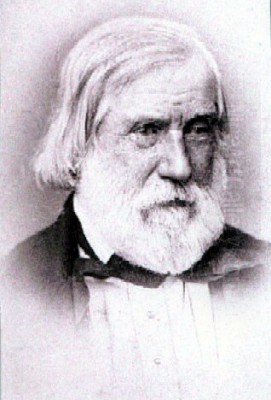
Francis Danby stands as a significant, if sometimes tumultuous, figure within the landscape of British and Irish Romantic art. Born in Ireland in 1793 and passing away in England in 1861, his career spanned a period of dramatic change and artistic innovation. Danby became renowned for his imaginative, often large-scale landscape paintings, frequently imbued with literary, historical, or biblical significance. His work, characterized by dramatic light effects and a powerful sense of the sublime, positioned him as a key member of the Bristol School and a notable rival to the celebrated painter John Martin. Despite periods of personal hardship and professional controversy, Danby produced a body of work that continues to fascinate, securing his place in the annals of art history.
Early Life and Artistic Awakening in Ireland
Francis Danby's origins lie in the rural south of Ireland, born near the town of Wexford. His father, James Danby, managed a small farm, providing a connection to the land that might have subtly influenced his son's later preoccupation with landscape. However, this pastoral existence was disrupted by James Danby's death in 1807. This event precipitated the family's move to the bustling environment of Dublin, a change that proved pivotal for the young Francis, who was then still a student.
In Dublin, Danby's artistic inclinations found a formal outlet. He enrolled in the drawing schools of the Royal Dublin Society, an institution dedicated to promoting arts and sciences in Ireland. It was here that he began to hone his technical skills. Crucially, during this formative period, he encountered James Arthur O'Connor, another aspiring young artist who would become a lifelong friend and early mentor. Under O'Connor's guidance, Danby began to seriously explore the possibilities of landscape painting, a genre that would come to define his career.
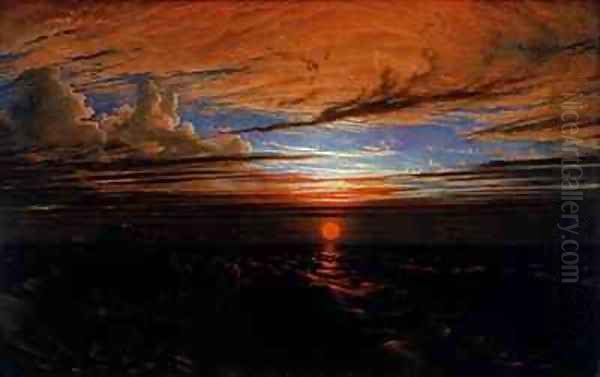
Another important friendship formed during these Dublin years was with George Petrie, who would also achieve recognition as an artist and antiquarian. The camaraderie among these young men fostered a shared enthusiasm for art and the Irish landscape. Around 1813, seeking broader opportunities, Danby, O'Connor, and Petrie embarked on an ambitious journey to London, the epicentre of the British art world. However, this initial foray proved challenging, and financial constraints soon forced Danby and O'Connor to curtail their London aspirations, walking part of the way back towards the west.
The Bristol School and Emerging Recognition
Instead of returning directly to Ireland, Danby made a decision that would profoundly shape his early career: he settled in Bristol around 1813 or 1814. This thriving port city, with its dramatic Avon Gorge and surrounding countryside, offered rich subject matter. More importantly, Bristol possessed a burgeoning artistic community. Danby quickly became associated with a group of artists who shared an interest in landscape, atmospheric effects, and often, a Romantic sensibility. This informal collective would become known as the Bristol School.
Key figures associated with the Bristol School, alongside Danby, included Edward Villiers Rippingille, Samuel Jackson, James Johnson, and Nathan Cooper Branwhite. They often sketched together outdoors, capturing the specific light and mood of the local scenery. During his Bristol years, Danby supported himself initially through teaching and selling watercolours, often depicting local views with increasing skill and sensitivity. He began sending more ambitious oil paintings to exhibitions in London, gradually building his reputation beyond the confines of Bristol.
A significant early success came with The Upas Tree of Java, exhibited at the British Institution in 1820. Based on a sensationalist, though largely fictional, account of a poisonous tree, the painting's exotic subject matter and dramatic rendering captured the public imagination. This work demonstrated Danby's flair for imaginative themes and his ability to create compelling, atmospheric scenes, signalling his arrival as an artist of considerable promise and ambition. His depictions of the local Avon Gorge, such as View of the Avon Gorge (c. 1822), also showcased his mastery of landscape during this period.
London Success and Rivalry
Around 1824, encouraged by his growing success, Francis Danby moved to London. This relocation marked a new phase in his career, bringing him into direct contact and competition with the leading artists of the day. He quickly made an impact on the London art scene, particularly at the prestigious Royal Academy exhibitions. His painting Sunset at Sea after a Storm (1824) was well-received, but it was The Delivery of Israel out of Egypt, exhibited at the Royal Academy in 1825, that truly established his fame.
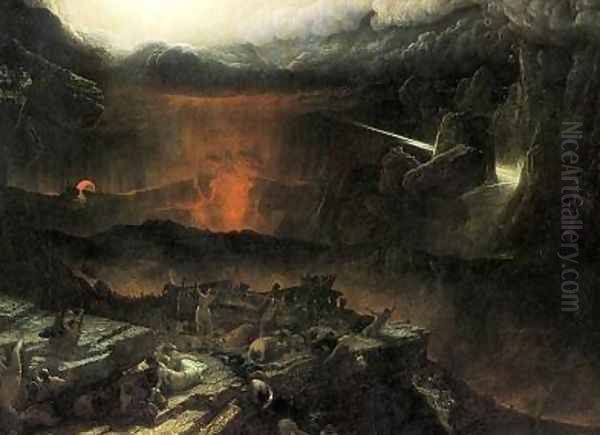
This large, dramatic canvas depicted the biblical story of the Israelites crossing the Red Sea with epic grandeur and striking light effects. Its success was immediate and substantial, leading to Danby's election as an Associate of the Royal Academy (ARA) that same year. The painting drew favourable comparisons with the work of J.M.W. Turner, the pre-eminent landscape painter of the era, particularly in its handling of light and atmosphere. It also placed Danby in direct competition with another master of the biblical sublime, John Martin.
Martin, known for spectacular works like Belshazzar's Feast, specialized in large-scale, dramatic scenes filled with architectural detail and apocalyptic fervor. Danby's Delivery of Israel and subsequent works, such as The Opening of the Sixth Seal (exhibited 1828), trod similar thematic ground. The Opening of the Sixth Seal, depicting a cataclysmic scene from the Book of Revelation, was another major success, purchased by the wealthy collector William Beckford. This period saw Danby operating at the height of his powers and popularity, his imaginative and dramatic style resonating strongly with the Romantic tastes of the time.
Personal Crisis and Self-Imposed Exile
Despite his professional triumphs, Danby's personal life became increasingly troubled, culminating in a scandal that significantly damaged his standing in London society and the art world. In 1829, Danby stood for election as a full Royal Academician (RA). His failure to secure election, losing out to John Constable, was a bitter disappointment. While artistic rivalries and Academy politics likely played a role, a major contributing factor was a burgeoning domestic scandal.
Danby's marriage to his wife, Hannah, had become deeply unhappy. While Danby was away from London, possibly in 1829, Hannah eloped with another artist, Paul Falconer Poole. This event caused a considerable stir and reflected poorly on Danby within the socially conservative circles of the Royal Academy. Feeling betrayed both personally and professionally – perhaps believing his rivals, including those allied with John Martin, had used the scandal against him – Danby made the drastic decision to leave London.
He initially moved to Paris before eventually settling near Lake Geneva in Switzerland around 1831. He remained abroad for over a decade, living what has been described as a somewhat bohemian existence with his mistress, Ellen Evans, and several of his children. During this period of self-imposed exile, he continued to paint, often producing calmer, more lyrical landscapes inspired by the Swiss scenery, though he also occasionally worked on grander themes. He also engaged in other pursuits, including boat building. This extended absence, however, removed him from the mainstream of the London art world, impacting his visibility and patronage.
Return to England and Later Career
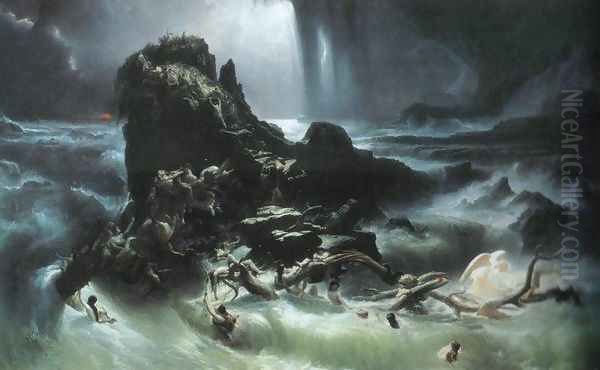
In 1840, Danby sent a monumental painting, The Deluge, to the Royal Academy exhibition in London. This powerful depiction of the biblical flood, echoing the dramatic themes of his earlier successes, marked a significant return to the public eye. Its favourable reception encouraged Danby to return permanently to England. He did not resettle in London or Bristol, but chose the coastal town of Exmouth in Devon, where he would live for the remainder of his life.
His return did not immediately restore him to the central position he had occupied in the 1820s, but he continued to produce significant works and exhibit regularly. He painted further large-scale historical and biblical subjects, alongside serene landscapes and seascapes inspired by the Devon coast and his memories of Norway (which he visited). Works like The Golden Age and The Evening Gun demonstrate the range of his later output, from idyllic visions to atmospheric marine paintings.
Although he never achieved the full Royal Academician status he had sought in 1829, Danby's reputation was largely rehabilitated. His later works reaffirmed his unique talent for combining landscape painting with imaginative and poetic themes. His two sons, James Francis Danby (1816-1875) and Thomas Danby (1817-1886), also became landscape painters, continuing the family's artistic legacy, though neither achieved the same level of fame as their father. Francis Danby died in Exmouth in 1861, recognized once more as a major figure in British art.
Artistic Style, Themes, and Influences
Francis Danby's art is firmly rooted in the Romantic movement, particularly its fascination with the Sublime – the evocation of awe, terror, and wonder, often through depictions of powerful natural forces or vast, dramatic landscapes. His style evolved throughout his career but consistently displayed a remarkable sensitivity to light and atmosphere. He was a master of depicting dramatic sunsets, ethereal moonlight, and the turbulent effects of storms, using light not just for illumination but for emotional and symbolic impact.
His compositions are often complex, featuring panoramic vistas, detailed foregrounds, and a sense of deep space. While capable of capturing naturalistic detail, particularly evident in his Bristol-period landscapes, his primary aim was often imaginative and poetic rather than purely topographical. His colour palette could range from the rich, jewel-like tones seen in works like The Delivery of Israel to more muted, atmospheric harmonies in his later seascapes.
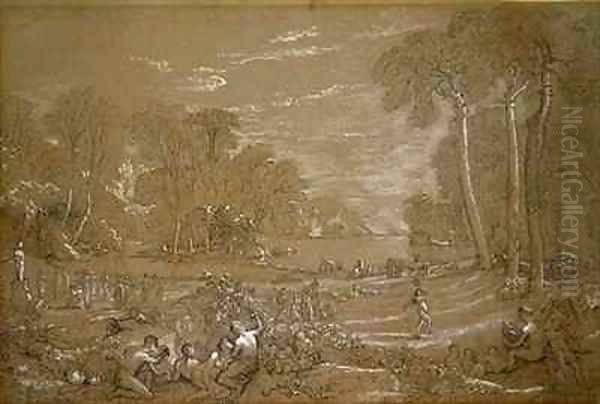
Danby drew inspiration from various sources. The idealized, light-filled landscapes of the 17th-century master Claude Lorrain were a clear influence, particularly on his more tranquil compositions like The Wood-nymph's Hymn to the Rising Sun. The wilder, more dramatic landscapes of Salvator Rosa may also have informed his approach. Among his contemporaries, the influence and rivalry with John Martin were significant, pushing both artists towards increasingly spectacular biblical and apocalyptic themes. He also operated in the same era as J.M.W. Turner and John Constable, though his style differed markedly from both – less focused on the abstract qualities of light and colour than Turner, and less concerned with empirical observation of nature than Constable. His work often incorporates narrative elements drawn from the Bible, mythology, or literature, embedding human drama within imposing natural settings.
Analysis of Key Works
Several paintings stand out as defining moments in Danby's career and exemplify his artistic concerns:
The Upas Tree (1820): This early success established Danby's reputation for imaginative and exotic subjects. Its dramatic lighting and depiction of a deadly landscape captured the Romantic fascination with the dangerous and the unknown.
View of the Avon Gorge (c. 1822): Representative of his Bristol period, this work showcases his skill in rendering specific locations with atmospheric sensitivity, capturing the dramatic cliffs and river central to the Bristol School's inspiration.
The Delivery of Israel out of Egypt (1825): A monumental work that secured his London fame and election as ARA. Its vast scale, dramatic chiaroscuro depicting the parting of the Red Sea, and intricate detail demonstrated his ambition and technical prowess in the genre of the biblical sublime.
The Opening of the Sixth Seal (1828): Perhaps his most direct engagement with the apocalyptic themes popularized by John Martin. This terrifying vision of cosmic destruction, based on the Book of Revelation, cemented his reputation as a painter of grand, dramatic spectacles.
The Wood-nymph's Hymn to the Rising Sun (exh. 1845): Painted after his return from exile, this work shows a more lyrical, Claudian aspect of his art, depicting an idealized pastoral scene bathed in the warm light of dawn, showcasing his versatility beyond catastrophic subjects.
The Deluge (1840): The painting that marked his comeback. A powerful and terrifying depiction of the biblical flood, it revisited the sublime themes of his earlier work with renewed vigour, demonstrating his enduring mastery of dramatic composition and atmospheric effect.
Relationships with Contemporaries
Danby's career unfolded within a vibrant and competitive art world. His relationship with James Arthur O'Connor began as mentorship and evolved into a lifelong friendship between fellow Irish landscape painters. His association with George Petrie and the Bristol School artists like E.V. Rippingille provided crucial support and artistic exchange during his formative years in England.
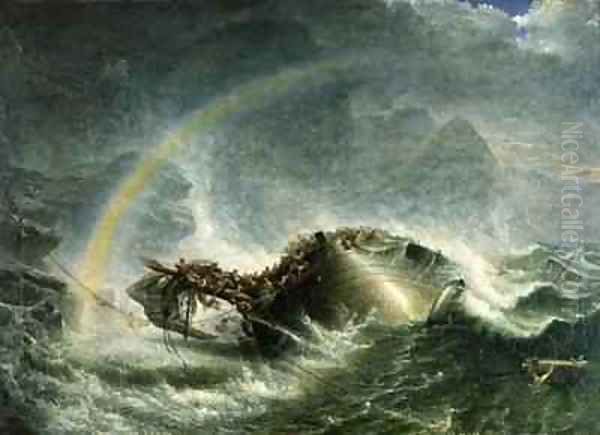
The most discussed relationship is undoubtedly his rivalry with John Martin. Both artists achieved immense popularity painting similar subjects – grand-scale biblical and historical scenes emphasizing catastrophe and the sublime. While their styles differed – Martin often more architectural, Danby perhaps more focused on atmospheric light – they were frequently compared and competed for patronage and critical acclaim. Danby reportedly felt Martin's drawing of figures could be weak, while the circumstances surrounding the 1829 RA election suggest a degree of professional antagonism, possibly fueled by Martin's supporters.
His relationship with the Royal Academy itself was complex. Early success led to his election as ARA, but the failure to gain full Academician status, intertwined with the scandal involving Paul Falconer Poole, led to bitterness and his long exile. He existed alongside, but stylistically distinct from, the giants of British landscape painting, Turner and Constable. While Turner explored the dissolution of form in light and atmosphere, and Constable pursued empirical truth to nature, Danby carved his own niche with imaginative, poetic, and often narrative-driven landscapes imbued with dramatic intensity. He also worked during the time of prominent artists in other genres, such as the narrative painter Sir David Wilkie and the ambitious history painter Benjamin Robert Haydon.
Legacy and Art Historical Position
Francis Danby occupies a distinct and important position within 19th-century British and Irish art. He was a leading exponent of the Romantic landscape, particularly adept at conveying the sublime through dramatic natural phenomena and imaginative interpretations of biblical and literary themes. As a central figure in the Bristol School, he contributed significantly to the development of landscape painting in the west of England.
His work enjoyed considerable popularity during his lifetime, particularly in the 1820s and again after his return to England. His major paintings were ambitious in scale and conception, rivaling those of John Martin in their dramatic impact. However, his reputation perhaps suffered in the long term compared to Turner and Constable, whose innovations proved more profoundly influential on the course of modern art. Danby's style, while powerful, was less revolutionary.
Nevertheless, his unique blend of poetic sensibility, dramatic flair, and technical skill produced a compelling body of work. His paintings are held in major public collections, including the Tate Britain, the National Gallery London, the British Museum, the National Gallery of Ireland, Bristol Museum & Art Gallery, and the Yale Center for British Art. Critical appreciation has fluctuated, but exhibitions and scholarship, particularly in the late 20th and early 21st centuries, have reaffirmed his significance as a highly original artist who navigated a path between observed landscape and visionary imagination.
Conclusion
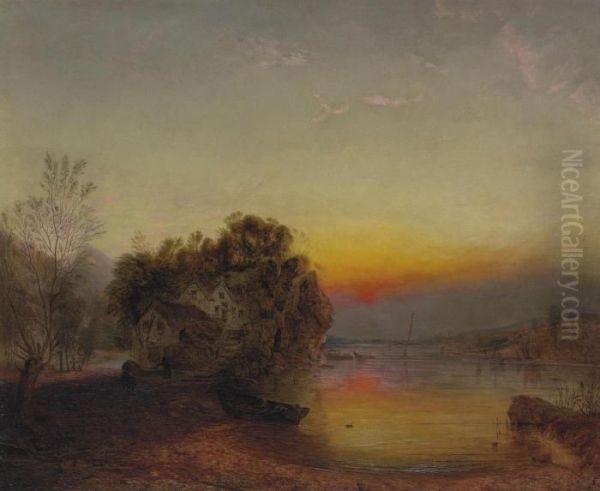
Francis Danby's life and art were marked by dramatic contrasts – early struggles followed by meteoric success, professional triumph overshadowed by personal scandal, long exile followed by a determined return. His paintings mirror this intensity, ranging from tranquil, light-filled idylls to terrifying visions of apocalypse. As an Irish artist who made his career primarily in England, he bridged different cultural contexts, while his role in the Bristol School highlights the importance of regional artistic centres. Though perhaps sometimes overshadowed by his contemporary John Martin, or by the towering figures of Turner and Constable, Danby remains a crucial figure for understanding the breadth and depth of Romantic landscape painting. His mastery of light, his imaginative power, and his ability to evoke the awe-inspiring force of the sublime ensure his enduring relevance in the history of art.